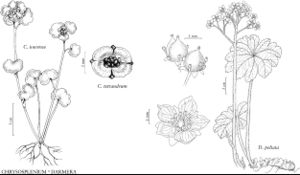Chrysosplenium
Sp. Pl. 1: 398. 1753.
Gen. Pl. ed. 5, 189. 1754 ,.
Herbs, rhizomatous, stoloniferous, (rhizomes and stolons with functional leaves or stolon leaves reduced, nonfunctional, scalelike); caudex absent. Flowering stems repent, decumbent, or ascending to erect, leafy or leafless, (1.2–)2–30 cm (often as short as 2 cm in C. wrightii), glabrous or sparsely to densely villous. Leaves cauline or arising from stolons or rhizomes, opposite or alternate; stipules absent; petiole present, glabrous or villous; blade ovate, depressed-ovate, depressed-elliptic, reniform, flabellate, or, sometimes, nearly orbiculate, unlobed, base attenuate, cuneate, truncate, or cordate, ultimate margins subentire, crenate, crenulate, or crenate-dentate, crenae sometimes prominent and margins appearing ± lobed, apex obtuse, rounded, or truncate, surfaces glabrous or sparsely villous to villous; venation palmate. Inflorescences simple or compound cymes, from terminal bud in rosette, 2–30-flowered, sometimes flowers solitary, bracteate. Flowers: hypanthium 1/2–3/4 adnate medially or distally to ovary, 0.5–1.5 mm free from ovary, greenish or yellow-green; sepals 4, yellow, greenish yellow, green, greenish red, reddish orange, or purple, sometimes purple-spotted; petals absent; nectary disc conspicuous or apparently absent; stamens 2–8, usually 4 or 8; filaments lanceolate to narrowly oblong; ovary 1/2–3/4-inferior, 1-locular, carpels connate 3/4–4/5 their lengths; placentation parietal; styles 2; stigmas 2. Capsules (cuplike after dehiscence), 2-beaked (beaks divergent). Seeds dark brown or reddish brown, ellipsoid, ovoid, or spheroid, smooth. x = 11.
Distribution
North America, s South America, Eurasia.
Discussion
Species ca. 60 (6 in the flora).
A wide range of chromosome numbers has been reported in Chrysosplenium. M. Nakazawa et al. (1997) and D. E. Soltis et al. (2001b) hypothesized that these numbers arose from an ancestral base of x = 11, with multiple lines of dysploidy (reported as aneuploidy). The historical division of the genus into two major clades—opposite-leaved species and alternate-leaved species—is supported by flavonoid (B. A. Bohm and F. W. Collins 1979) and molecular data (Nakazawa et al.; Soltis et al.). Phylogenetic analyses using the rbcL and matK genes (Nakazawa et al.; Soltis et al.) have provided limited resolution for species-level relationships.
The relationship of the alternate-leaved, North American species to those in Europe and Asia has not been examined in detail. Morphological similarities between the North American species and Eurasian Chrysosplenium alternifolium Linnaeus have caused some authors to treat C. iowense, C. rosendahlii, C. tetrandrum, and C. wrightii as infraspecific taxa of C. alternifolium. Each of them is maintained here as a distinct species pending further studies.
Stamen number can vary among flowers within an inflorescence in some alternate-leaved species (C. O. Rosendahl 1947; J. G. Packer 1963), with lateral flowers sometimes smaller and having fewer stamens than the central flowers. In species usually producing eight stamens, Packer observed that variable stamen numbers resulted from the systematic failure of stamens to develop. Stamens alternating with the styles are suppressed first. In flowers with fewer than four stamens, the stamens alternating with the styles are suppressed. This corresponds with developmental observations made by L.-P. Ronse Decraene et al. (1998) in Chrysosplenium alternifolium Linnaeus.
D. B. O. Savile (1953) demonstrated splash-cup dispersal of seeds in Chrysosplenium americanum, reporting a maximum dispersal distance of 40 cm in the laboratory. R. M. Weber (1979) reported a maximum dispersal distance of 30 cm for C. iowense in the field and 45 cm in the laboratory. Among three Japanese species examined in the field, H. Nakanishi (2002) reported a maximum dispersal distance of 116 cm.
Selected References
Lower Taxa
Key
| 1 | Leaves opposite, sometimes alternate distally; inflorescences solitary flowers or open cymes | > 2 |
| 1 | Leaves alternate; inflorescences compact cymes | > 3 |
| 2 | Anthers purple, red, or orange; leaf blade margins subentire or 5-7(-9)-crenate or -crenulate; seeds puberulent; c, e North America. | Chrysosplenium americanum |
| 2 | Anthers yellow; leaf blade margins 9-17(-21)-crenate or -crenate-dentate; seeds glabrous; w North America. | Chrysosplenium glechomifolium |
| 3 | Nectary discs prominent, yellow or purple, 8-lobed; stolons white, tan, or yellowish, 1-2.5(-3) mm diam., usually densely villous, hairs reddish brown; stamens 8; leaves fleshy; petioles of stolon leaves sparsely to densely villous, hairs reddish brown. | Chrysosplenium wrightii |
| 3 | Nectary discs apparently absent or yellow, unlobed; stolons white, 0.3-1.2 mm diam., sparsely villous, hairs white, reddish brown, or purplish; stamens 2-8; leaves membranous or fleshy; petioles of stolon leaves sometimes glabrous, usually sparsely villous, hairs white or reddish brown | > 4 |
| 4 | Stamens (3-)4; sepals usually erect, sometimes spreading. | Chrysosplenium tetrandrum |
| 4 | Stamens 2-8; sepals spreading | > 5 |
| 5 | Sepals yellow or greenish yellow, not purple-spotted; temperate or boreal. | Chrysosplenium iowense |
| 5 | Sepals green or greenish yellow, usually purple-spotted distally, rarely not purple-spotted; arctic. | Chrysosplenium rosendahlii |
